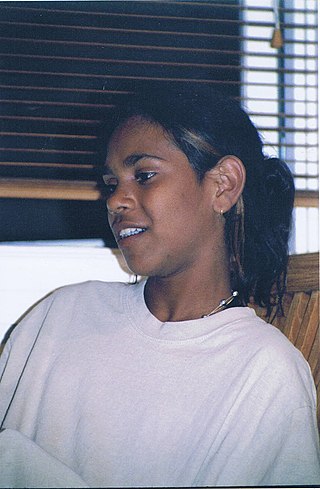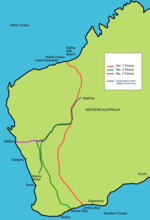
Everlyn Lee Marie Sampi is an Australian actress. She is of Bardi Australian Aboriginal and Scottish descent.

David Dhalatnghu Gulpilil was an Australian actor and dancer. He was known for his roles in the films Walkabout (1971), Storm Boy (1976), The Last Wave (1977), Crocodile Dundee (1986), Rabbit-Proof Fence, The Tracker and Australia (2008).
Hyperdescent is the practice of classifying a child of mixed race ancestry in the more socially dominant of the parents' races.

Phillip Noyce is an Australian film and television director. Since 1977, he has directed over 19 feature films in various genres, including historical drama ; thrillers ; and action films. He has also directed the Jack Ryan adaptations Patriot Games (1992) and Clear and Present Danger (1994), as well as the 2014 adaptation of Lois Lowry's The Giver.
The rabbit-proof fence or pest-exclusion fence is one that crosses the state of Western Australia from north to south.

The State Barrier Fence of Western Australia, formerly known as the Rabbit-Proof Fence, the State Vermin Fence, and the Emu Fence, is a pest-exclusion fence constructed between 1901 and 1907 to keep rabbits, and other agricultural pests from the east, out of Western Australian pastoral areas.
The 1st San Francisco Film Critics Circle Awards, honoring the best in film for 2002, were given on 17 December 2002.
The 74th National Board of Review Awards, honoring the best in filmmaking in 2002, were announced on 4 December 2002 and given on 14 January 2003.
Doris Pilkington Garimara, also known as Doris Pilkington, was an Aboriginal Australian author.

Catherine Edith Macauley Martin was an Australian novelist who used the pseudonyms M.C. and Mrs Alick MacLeod, also published anonymously.
The Martu (Mardu) are a grouping of several Aboriginal Australian peoples in the Western Desert cultural bloc.

The Film Finance Corporation Australia (FFC) was the government agency responsible for funding commercial productions of Australian film, documentary, and television from 1988 to 2008. Unlike other publicly funded organisations responsible for financing media production in Australia, the FFC operated as a commercially oriented funding agency, backing projects with the intention of recouping part of its funding through investment. The organisation was responsible for financing several notable Australian feature films, among them Strictly Ballroom (1992), Muriel's Wedding (1994) and The Adventures of Priscilla, Queen of the Desert (1994). During its lifetime, the FFC supported 248 features with a total investment of A$662 million. In 2008, the FFC was succeeded by Screen Australia, which merged the similar film financing bodies operated by the Australian government.

Follow the Rabbit-Proof Fence is an Australian book by Doris Pilkington, published in 1996. Based on a true story, the book is a personal account of an Indigenous Australian family's experiences as members of the Stolen Generation—the forced removal of mixed-race children from their families during the early 20th century. It tells the story of three young Aboriginal girls: Molly, Daisy, and Gracie, who are forcibly removed from their families at Jigalong and taken to Moore River, but escape from the government settlement in 1931 and then trek over 1,600 kilometres (990 mi) home by following the rabbit-proof fence, a massive pest-exclusion fence that crossed Western Australia from north to south.
Jigalong is a remote Aboriginal community of approximately 333 people located in the Pilbara region of Western Australia.

John Winter is an Australian film and television writer, director and producer. He is best known for producing Rabbit-Proof Fence, Doing Time for Patsy Cline and Paperback Hero. His directorial debut Black & White & Sex premiered at the 2011 Sydney Film Festival with its international premiere at the 41st International Film Festival Rotterdam. The film won the 'Best Experimental' at the 2012 ATOM Awards.
Balfour Downs Station is a pastoral lease and cattle station located approximately 132 kilometres (82 mi) northeast of Newman, 88 kilometres (55 mi) east of Roy Hill and 108 kilometres (67 mi) southeast of Nullagine in the Pilbara region of Western Australia. At 6,395 square kilometres (2,469 sq mi), it is among the largest cattle stations in Australia.

Emile Sherman is an Australian film and television producer best known for producing the film The King's Speech (2010), for which he won an Academy Award for Best Picture and the BAFTA award for Best Film and Best British Film, and for executive producing television series Top of the Lake, which was nominated for an Emmy, BAFTA and Golden Globe award. He has been nominated for three Academy Awards and won one; nominated for five BAFTAs and won three, and nominated for two Emmy Awards and won one.
Molly Kelly was an Australian Martu Aboriginal woman, known for her escape from the Moore River Native Settlement in 1931 and subsequent 1,600 km (990 mi) trek home with her half-sister Daisy Kadibil and cousin Gracie Cross. She was a member of the Stolen Generations, who were part-white, part-Aboriginal children forcibly removed from their families by the Australian government. Her story was the inspiration for the book Follow the Rabbit-Proof Fence and the film Rabbit-Proof Fence.
Ningali Josie Lawford, also known as Ningali Lawford-Wolf and Josie Ningali Lawford, was an Aboriginal Australian actress known for her roles in the films Rabbit-Proof Fence (2002), Bran Nue Dae (2009), and Last Cab to Darwin (2015), for which she was nominated for the AACTA Award for Best Actress in a Leading Role.

Daisy Kadibil was an Aboriginal Australian woman whose experiences shaped the 1996 book Follow the Rabbit-Proof Fence, written by her niece Doris Pilkington Garimara and the subsequent 2002 film Rabbit-Proof Fence.











